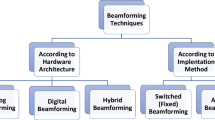Abstract
In contrast to the orthogonal multiple access (OMA), non-orthogonal multiple access (NOMA) was shown to have outstanding performance in terms of spectrum efficiency, user fairness and signalling cost. In order to further promote the QoS of NOMA, an interference alignment and NOMA (IA-NOMA) combined strategy was proposed and analysed in this paper. In the two-user model, the proposed IA-NOMA showed significant performance improvements in terms of bit error rate. By considering a more generalised scenario, the idea of IA-NOMA was extended from the two-user model to a massive-user network. In this context, a cluster based IA-NOMA (CIA-NOMA) algorithm was proposed, and the sum-rate and outage probability of the CIA-NOMA was derived. The QoS of CIA-NOMA in terms of outage probability and effective data rate were demonstrated under different target rates. For the results of outage probability, it was shown that the CIA-NOMA outperformed NOMA-only method, especially under a low target rate case. Correspondingly, in terms of effective capacity, the CIA-NOMA required less transmit power than the NOMA-only method to achieve a target data rate.













Similar content being viewed by others
References
Ghosh, A., & Ratasuk, R. (2014). Essentials of LTE and LTE-A. Cambridge: Cambridge University Press.
Boccardi, F. (2014). Five disruptive technology directions for 5G. IEEE Communications Magazine, 52(2), 74–80.
Dai, L., Wang, B., Yuan, Y., Han, S., Chih-Lin, I., & Wang, Z. (2015). Nonorthogonal multiple access for 5G: Solutions, challenges, opportunities, and future research trends. IEEE Communications Magazine, 53(9), 74–81.
Saito, Y., Kishiyama, Y., Benjebbour, A., Nakamura, T., Anxin, L., & Higuchi, K. (2013). Non-orthogonal multiple access (NOMA) for cellular future radio access. In 2013 IEEE 77th vehicular technology conference (VTC Spring) (pp. 1–5).
Timotheou, S., & Krikidis, I. (2014). Fairness for non-orthogonal multiple access in 5G systems. IEEE Signal Processing Letters, 22(10), 1647–1651.
Ding, Z., Yang, Z., Fan, P., & Poor, H. V. (2014). On the performance of non-orthogonal multiple access in 5G systems with randomly deployed users. IEEE Signal Processing Letters, 21(12), 1501–1505.
Tian, Y., Nix, A. R., & Beach, M. (2016). On the performance of opportunistic NOMA in downlink CoMP networks. IEEE Communications Letter, 20(5), 998–1001.
Ding, Z., Adachi, F., & Poor, H. V. (2016). The application of MIMO to non-orthogonal multiple access. IEEE Transactions on Wireless Communications, 15(1), 537–552.
Xu, P., Ding, Z., Dai, X., & Poor, H. V. (2015). A new evaluation criterion for non-orthogonal multiple access in 5G software defined networks. IEEE Access, 3, 1633–1639.
ETSI (2008). Framing structure, channel coding and modulation for satellite services to handheld devices (SH) below 3 GHz. ETSI EN 302583 V1.1.1 (2008-03), Digital video roadcasting (DVB).
Choi, J. (2016). On the power allocation for a practical multiuser superposition scheme in NOMA systems. IEEE Communications Letters, 20(3), 438–441.
Kaneko, M., Yamaura, H., Kajita, Y., Hayashi, K., & Sakai, H. (2015). Fairness-aware non-orthogonal multi-user access with discrete hierarchical modulation for 5G cellular relay networks. IEEE Access, 3, 2922–2938.
Tse, D., & Viswanath, P. (2005). Fundamentals of wireless communication. Cambridge: Cambridge University Press.
Ding, Z., Fan, P., & Poor, H. V. (2016). Impact of user pairing on 5G nonorthogonal multiple-access downlink transmissions. IEEE Transactions on Vehicular Technology, 65(8), 6010–6023.
Dai, L., Wang, B., Yuan, Y., Han, S., Chih-Lin, I., & Wang, Z. (2015). Non-orthogonal multiple access for 5G: Solutions, challenges, opportunities, and future research trends. IEEE Communications Magazine, 53(9), 74–81.
Zhao, N., Yu, F. R., Jin, M., Yan, Q., & Leung, V. C. M. (2016). Interference alignment and its applications: A survey, research issues, and challenges. IEEE Communications Surveys and Tutorials, 18(3), 1779–1803.
Zhao, N., Yu, F. R., Chen, Y., & Leung, V. C. M. (2017). Collusive eavesdropping in interference alignment based wireless networks. IEEE Transactions on Wireless Communications, 16(8), 5549–5561.
Funding
This work was supported in part by the National Natural Science Foundation of China under Grant 61801412, and in part by the High-Level Personnel Foundation of Xiamen University of Technology under Grant (G2018005)YKJ18005R.
Author information
Authors and Affiliations
Corresponding author
Additional information
Publisher's Note
Springer Nature remains neutral with regard to jurisdictional claims in published maps and institutional affiliations.
Rights and permissions
About this article
Cite this article
Tian, Y. A Non-orthogonal Multiple Access and Interference Mitigation Combined Strategy in Multi-user Networks. Wireless Pers Commun 104, 111–128 (2019). https://doi.org/10.1007/s11277-018-6011-z
Published:
Issue Date:
DOI: https://doi.org/10.1007/s11277-018-6011-z




